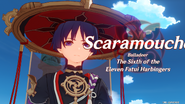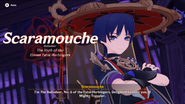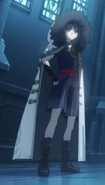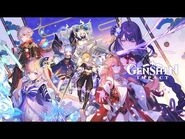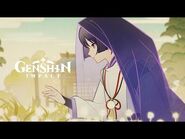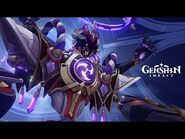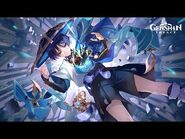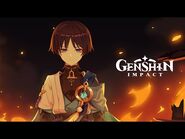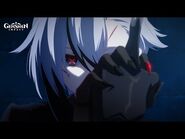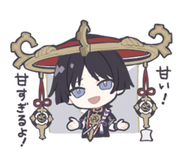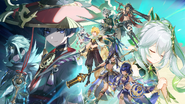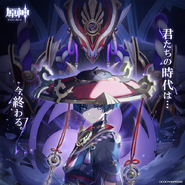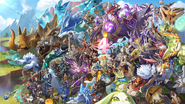Scaramouche, also known as The Balladeer and Kunikuzushi (Japanese: 国崩),[10][11] was the Sixth of the Eleven Fatui Harbingers.
Scaramouche is a puppet created by Raiden Ei who appears as a minor antagonist throughout the game, becoming a major antagonist in Sumeru as Shouki no Kami. Following his defeat and learning the truth of the Tatarasuna Incident, he erases his existence from the Irminsul and becomes the Wanderer.
Profile[]
Scaramouche first appears as "???" during the Unreconciled Stars Event Quest The Crisis Deepens, where he introduced himself as a "vagrant from Inazuma." While he appeared to be friendly at first, he learns of the Traveler's identity as the Honorary Knight and tries to strike them down, only to be stopped by Mona, who realized his intentions and helped the Traveler escape just in time.
It is later revealed that he traveled to Liyue to investigate mysterious meteorites and entered a dream where he realized that the stars and sky are a "lie" and that "The Jester" had intentionally sent him without forewarning what would happen. After leaving a promising threat against the Traveler, he took his leave to confront the senior Harbinger.
He later headed to Inazuma to oversee the creation of Delusions at a secret facility and confronted the Traveler, recognizing them from before. Rather than facing them head on, he incited them into succumbing to the old gods' wrath, but the plan was partially foiled when Yae Miko walked in. She then negotiated for the Traveler's safety by offering Ei's Gnosis, which he accepted and allowed them to leave safely.
After obtaining the Gnosis and Signora's death, Scaramouche cut off contact with the Fatui, causing them to believe he had gone rogue. Childe went to Inazuma to track him down to no avail.[12] When the Harbingers convened at Signora's funeral, Il Capitano asked Il Dottore about him, in which Dottore anticipated that Scaramouche would make his move soon.[13]
With Dottore's assistance, the sages of Sumeru Akademiya worked to ascend Scaramouche into a new God of Wisdom under the name of "Shouki no Kami, the Prodigal," comparable to Greater Lord Rukkhadevata. He also gained a follower in the form of Haypasia, who had managed to see his past during her connection to Irminsul. Showcasing his new power to the Traveler after learning Dottore was after her, he hurls lightning across Pardis Dhyai, striking Tighnari as collateral damage in the process. The Traveler eventually returned with Nahida, the vessel of Lesser Lord Kusanali, and managed to defeat him after a prolonged fight, during which Nahida removed the Electro Gnosis powering his new form, much to his horror. In his attempt to beg Nahida not to remove it, he accidentally broke out from the tubing connecting him to his mechanical suit, causing him to fall to the ground and into a coma. Nahida would put him into her custody afterwards, hiding him in a secret location.
Scaramouche would soon recover and, knowing that he had no allies to rely on as Dottore had left with the two Gnoses, makes a deal with Nahida to search Irminsul on her behalf and also help the Traveler despite being on uneasy terms with them. During the investigation, Nahida left behind the true events of the Tatarasuna incident for him to discover. Scaramouche was disgusted to learn that his second "betrayal" was masterminded by Dottore and decides to give his friends a second chance by erasing himself from Irminsul as the Kabukimono and his Fatui codename. This would retroactively cause his former seat to be remembered as being unoccupied for hundreds of years, but otherwise leave unchanged the tragedies that happened, as they still occurred with seemingly different actors and causes, as the altered memories and records convey.
The Traveler would eventually discover Scaramouche's new incarnation as a wanderer, having somehow made his way to Sumeru in spite of having no recollection of his actual past. The Wanderer agrees to inherit Scaramouche's memories despite the pain and anguish it would bring. During the process, the Everlasting Lord of Wisdom emerged to attack, but he recovers and defends the Traveler, gaining an Anemo Vision in the process. Forsaking his previous identities and the Fatui, he took on a new name and promises to help the Traveler behind the scenes when needed while desiring revenge against Dottore.
Appearance[]
Scaramouche is described as having a slender figure and a beautiful face.[8] He has been described to be beautiful numerous times within text, short in height with indigo hair that covers his ears, as well as indigo eyes with bold red eyeliner.
His attire consists of black shorts and black sandals, and a large hat with four upwards-curving hooks along the circumference, and what seems to be his mask on the center. Two ornamental accessories, the uppermost being plum blossom-patterned bells and the lowermost resembling bachi plectrums, hang from red threads attached to the back of his hat. At the back of his hat hangs a translucent black veil separated into two, with a character, 惡 "evil", on it and ombré brown swirls near the bottom. Scaramouche wears a short-sleeved shirt with a crest resembling the Electro symbol on it, as well as a purple checkered pouch on his back. His overall attire resembles traditional Japanese wear.
While in Snezhnaya, Scaramouche wore a formal Harbinger winter coat over his regular attire, subbing his hat out in favor of his coat's hood and replacing his sandals with winter boots. His coat has a white and purple string that can be seen on his usual outfit.
Story[]
Pre-Fatui Life[]
The Raiden Shogun sought to create a puppet body who could inherit her power and rule over Inazuma in her stead, as she desired to retreat into her own mind and meditate on the true meaning of "eternity” while escaping erosion. But before the Raiden Shogun (Ei) managed to create a finalized puppet of her own godly form, she took it up herself to create prototype puppets, with Scaramouche being one of them. This nameless puppet was meant to be a proof of the concept, and its appearance and intellect were not directly based on Ei.
After observing the puppet shed tears during his sleep, Ei thought it would be too cruel to interfere with his fate or end his existence, deciding to “free him” instead. Rather than disposing of her prototype, Ei instead opted to seal away his divine power, placing him into stasis in a hidden mansion on Inazuma's Yashiori Island called Shakkei Pavilion.
Later on, the puppet came to believe that she had deemed him a failure and for that, abandoned him. For a long time the puppet, whose sole possession was a golden feather given to him by the Electro Archon, was only capable of observing his surroundings as his perception of reality slowly slipped away from him. Eventually, he was discovered and freed by Inspector Mikoshi Nagamasa's yoriki Katsuragi, who had come across the hidden pavilion after a landslide. In order to hide the puppet's noble origins, Katsuragi claimed to have found him wandering by the shore instead. Nagamasa's group referred to him as the Kabukimono (wandering eccentric),[3] as he had no name at the time. The Kabukimono grew close with Katsuragi and, after the forging of the Daitatara Nagamasa, performed a sword dance with him.[14]
Dottore, who had infiltrated Tatarasuna to pave the groundwork for the Fatui's future endeavors in Inazuma, disguised himself as Escher and revolutionized the forging process in the Mikage Furnace to help smith weapons by using Crystal Marrow. However, the people did not know that the marrow was the remains of Orobashi and that it contained malevolent energy, which began to kill the people over time. Kabukimono went to the Shogun to request an audience, while Niwa Hisahide was murdered by Dottore. The Kabukimono was unsuccessful in getting the Shogun's aid and, when he returned, was told by Dottore that Niwa had fled and left the people to his fate. The Kabukimono proceeded to enter the heart of the furnace with a mysterious box that Dottore gave him and purged the furnace of its filth, which he survived in spite of the load being extreme. When Dottore told him to open the box, he found a withered human heart, which Dottore claimed was from a subordinate that Niwa had killed. The idea that Niwa gave him the heart he so desired through an act of immense cruelty horrified the Kabukimono, and overwhelmed with anger and sorrow, he threw the heart away and left Tatarasuna. He would come to regard Niwa's presumed actions as the second of his life's betrayals.[11][15][16]
At some point after this, he befriended a young boy plagued with an illness, who was a child of Tatarasuna crafts-people.[17][Note 1] The boy made a promise to live together with him as family,[3] but later died, breaking his promise. The Kabukimono considered this his life's third and final betrayal, and he began wandering across Inazuma.
Fatui Recruitment[]
The puppet eventually was found by Pierro, who persuaded him to join the Fatui and take his place at the banquet against the divine. Intrigued by the Jester's words, he joined their ranks and had his innate power as an Archon's creation unlocked in exchange for becoming a subject of Dottore's research and experiments. The following century, he would lead an expedition to the Abyss per orders of the Tsaritsa. After a series of injuries, repairs and enhancements, the puppet would eventually finish his expedition and bring result back to Snezhnaya, gaining the position of The Balladeer, the Sixth of the Eleven Fatui Harbingers, in the process. Since then, his orders were changed to constantly be on standby, assisting the clandestine activities of the Fatui across the world, which includes helping Pierro with more expeditions to the Abyss.[11][18][19][20] It is unclear whether this occurred before or during the Case of the Eccentric, which he masterminded and the Fatui assisted in.[21]
He would eventually be present when Pierro appointed Arlecchino as a Harbinger replacement for Crucabena under the Tsaritsa's orders.
Case of the Eccentric[]
At some point in time, the Futsu, Hyakume and Senju arts of Inazuma's famous five bladesmithing practices, the Raiden Gokaden, fell from grace as a result of Scaramouche's manipulations, done in an act of revenge against "the bladesmith." Scaramouche also took on the name "Kunikuzushi" during this time. Scaramouche then turned his attention towards the Isshin Art and sabotaged a diagram of a Goshintou blade, which caused all of the Isshin craftsmen to create defective blades and flee when the deadline approached, taking refuge with the Fatui and entering exile in Snezhnaya.[21][22]
Kaedehara Yoshinori and the Yashiro head at the time proceeded to hunt the craftsmen, but were led to Scaramouche who confessed to the crime before dispatching the entire group with ease. However, he appeared to recognize Yoshinori and asked him if he knew of "Niwa," which he confirmed. Scaramouche then told him to let "her" know his name, Kunikuzushi, before leaving. The incident caused Yoshinori and the Yashiro head to never speak of the incident for fear of Scaramouche's retribution. Yoshinori also decided to no longer maintain the Isshin Art.
Removal From Irminsul[]
Scaramouche attempted to remove himself from Irminsul during the Archon Quest The Night-Bird Falls at the Curtain's Call in Interlude Chapter: Act III - Inversion of Genesis. He successfully removed all significant traces of his life up to that point, but he himself continued to exist afterward as the Wanderer.
Scaramouche's attempted removal of himself had the following consequences:
- Ei and Yae Miko's "About Kunikuzushi" voice-overs and Tartaglia's "About The Balladeer" voice-over are removed.
- Nahida's "About The Balladeer" voice-over is not removed, even temporarily.
- Mikhail and Lyudmila's dialogue regarding the recent events in Sumeru is slightly altered to discuss Signora instead of Scaramouche, and Mikhail mentions that the Sixth Harbinger's seat has been vacant for hundreds of years.
- Viktor's dialogue about Scaramouche in the World Quest Equivalent Exchange is changed to instead talk about Tartaglia.
- Viktor's mention of Scaramouche in the Mondstadt Commission Return to Days of Winter is removed.
- Tatarasuna's known history from 400 years ago, including the Tatarasuna Mystery, was changed to eliminate the kabukimono's presence. The extra tragedies related to him that Dottore brought about due to both his interest in the kabukimono (Scaramouche) and his mission from Pierro to sabotage Tatarasuna still occurred, but are now remembered to have happened through slightly different means. The Traveler personally verifies many of these changes during A Dance of Destruction and The Kabukimono's Finale immediately following Scaramouche's attempted removal of himself.
- Text regarding a "wandering eccentric" from the Rather Aged Notes in Inazuma is removed.
- In Aqaba's report, the suspicious figure changes from the "puppet" to a mechanic from Fontaine (Dottore as Escher).
- Niwa Hisahide is now believed to have died with another swordsmith, both having jumped into the furnace to purge Tatarasuna of its filth and stabilize the furnace. In the original version, Niwa intended to sacrifice himself to stabilize the furnace using Dottore's device, only for Dottore to murder him and extract his heart from his body to power the device. Niwa's fate remained a mystery to the general populace, who believed he had fled with his family.
- Interestingly, Aqaba and Sawada's documents still regard Niwa as having disappeared under mysterious circumstances in the revised history, even though Amenoma Tougo gives a clear story regarding Niwa's fate.
- Records and memories of the fall of most of the Raiden Gokaden, including the Case of the Eccentric, was heavily altered. The Traveler personally verifies many of these changes during A Dance of Destruction immediately following Scaramouche's attempted removal of himself.
- The fall of the Futsu, Hyakume, and Senju and the near-fall of the Isshin are now attributed to an indiscriminate murder spree by the head of the Hyakume Clan, who was a descendant of the swordsmith who died with Niwa Hisahide in the revised history and inherited the swordsmith's son's resentment towards Inazuma. In the original history, the four schools suffered from various seemingly natural misfortunes orchestrated by Scaramouche.
- Kaedehara Yoshinori's Letter, a quest item from Hues of the Violet Garden, is changed to describe the encounter with the vengeful Hyakume bladesmith instead of the encounter with Scaramouche.
- While not confirmed, it is possible that the Case of the Eccentric is no longer referred to as such, as "eccentric" was used to describe Scaramouche but not the vengeful Hyakume bladesmith.
- While he could not eliminate himself from Teyvat and continued to exist as the Wanderer, he did lose his memories of his previous identities since those were successfully removed.
- The Wanderer still knew himself to be a puppet even before his memories were restored. Further details on his and others' perceptions, such as Ei's perception, of the Wanderer's existence as a puppet are unknown.
The following Weapon and Artifact descriptions, which have not been affected by Irminsul modifications, retain their references to Scaramouche or events related to him:
- The artifact Surpassing Cup
- The artifacts in the set Husk of Opulent Dreams
- The weapon Kagura's Verity
- The weapon Kagotsurube Isshin
The following reference to Scaramouche was removed for all players in Version 3.3, regardless of their completion of The Night-Bird Falls at the Curtain's Call:
- Shakkei Pavilion's domain description
Quests and Events[]
Archon Quests
Events
- Unreconciled Stars
- Act II: The Crisis Deepens (as "???")
- Act III: What the Skies Conceal, the Water Reveals
- Act IV: Where Ancient Stars Align
- Hues of the Violet Garden
Character Mentions[]
Character Stories
| Character | Stories |
|---|---|
Character Voice-Overs
| Character | Voice-Overs |
|---|---|
| |
As Kunikuzushi:
| |
| |
As Kunikuzushi:
|
Trivia[]
- While playing the Archon Quest Delusion in Chapter II: Act III - Omnipresence Over Mortals, the dialogue changes depending on whether or not the player experienced the Version 1.1 event Unreconciled Stars. The Archive entry for the quest only lists the version where the player did not experience Unreconciled Stars.
- Even though Paimon and the Traveler only ever hear him go by "The Balladeer," Paimon later refers to him as "Scaramouche," a name which is only given to the player during his introduction screen in Unreconciled Stars and in his dialogue boxes. This discrepancy is the result of the English localization using "The Balladeer" and "Scaramouche" interchangeably for a single Chinese term, 散兵 Sǎnbīng.
- The cinematic cutscene in the Archon Quest The Gaze From a Certain God in Chapter III: Act III - Dreams, Emptiness, Deception symbolically depicts Ei's abandonment of Scaramouche, with Scaramouche dropping from his puppet strings and landing in front of a Domain that seems to be Slumbering Court.
- The same cutscene also implies that Katsuragi's misconduct was either him or Mikoshi Nagamasa attacking Scaramouche in an act of fear due to seeing him "as an abomination." What led up to this incident, and why either character saw Scaramouche in this light is currently unknown.
- The lowermost accessories hanging from the red threads attached to Scaramouche's stylized kasa resemble bachi plectrums, which are used to play traditional Japanese string instruments, such as the shamisen. This could allude to his title as the Balladeer, and could also allude to the various references to Kabuki theater in his design, name, and lore.
- This could also be because in commedia dell'arte, Scaramouche is sometimes depicted playing a lute, and a shamisen is a three-stringed fretless traditional Japanese lute.
Etymology[]
- Scaramouche (Scaramuccia in Italian) is derived from a stock character in commedia dell'arte, a type of Italian theatre.
- Scaramouche ("Little Skirmisher") is usually an assortment of different villainous traits, but is primarily unscrupulous and unreliable with a penchant for intrigue, which lands him into difficult situations.
- Unlike his fellow Harbingers, Scaramouche does not wear a mask on his face, but on the top of his hat. This could relate to the original commedia dell'arte actor Tiberio Fiorillo, the role for Scaramouche, who played without a mask.
- Scaramouche's stylized kasa may be a reference to the character's costume; it consisted of a large loose hat that hung down over his neck.
- The bachi plectrums hanging from his hat may also allude to the fact that the character is sometimes depicted playing a lute.
- The term scaramouche has become associated with a class of puppets with extendable necks, which may be attributed to the fact that Scaramouche was originally a prototype for the Raiden Shogun's puppet.
- Kunikuzushi (Japanese: 国崩), the name he currently uses for himself, literally means the "Country Destroyer" in Japanese. In Mandarin, the word 国崩 guóbēng unambiguously means the collapse of a country. This contrasts with the Japanese usage of Han characters wherein 国崩 has two equally possible interpretations: the collapse of a country (Japanese: 国崩れ kuni kuzure) and the destroyer of (or the act of destroying) a country (Japanese: 国崩し kuni kuzushi). Historical canons, traditional stock characters, and the English name of the in-game character follow the latter reading.
- Kunikuzushi is a villainous stock character in kabuki, a traditional form of Japanese popular drama,[23] which also exists in the Genshin universe as Inazuman traditional theater.[11] Kunikuzushi typically appears in works whose theme is O-Ie Soudou (noble family disputes), where it plots to usurp a country. Kunikuzushi is considered to be one of the most heinous yet energetic and prominent stock characters in kabuki, and its importance usually demands the role to be played by the head or the star of a kabuki troupe.[23]
- In the Version 3.3 trailer, Scaramouche says "From this day forth, 'Balladeer' and 'kabukimono' will cease to exist." The name "kabukimono" (Japanese: 傾奇者) is a Japanese reading of the term that was localized as "wandering eccentric" in the Rather Aged Notes, and refers to wandering samurai who wore unusual or exotic clothing and formed street gangs during times of peace.
- Various aspects of Scaramouche's character, particularly pertaining to his appearance during Unreconciled Stars, reference the lyrics of the song "Bohemian Rhapsody" by British rock band, Queen, which has a famous line that goes "Scaramouche, Scaramouche, will you do the fandango?"
- The soundtrack that plays during Scaramouche's first appearance in the event is named "Ominous Fandango."
- The lyrics mention "Beelzebub," an alternative form of Beelzebul, who is Scaramouche's creator. The song's speaker addresses his "mama" several times, which may be an interpretation of the type of relationship between Beelzebul and Scaramouche.
- "Thunderbolt and lightning" are mentioned in the lyrics, which is symbolic of Inazuma, the Electro region, where Scaramouche originates from.
- The lyrics "Is this the real life? Is this just fantasy?" show the song's speaker having doubts about the natural order of the world. The song also makes reference to Galileo Galilei, who was known for challenging beliefs about the astronomical model during his time. Towards the end of Unreconciled Stars, Scaramouche makes a discovery that prompts him to declare: "The stars, the sky... It's all a gigantic hoax. A lie."
- The lyrics "Any way the wind blows" is the name of the Wanderer's Collected Miscellany video, in reference to his Anemo Vision.
- The lyrics "I sometimes wish I'd never been born at all." is referenced in his attempt to retroactively prevent his own birth in the Archon Quest Interlude Chapter: Act III - Inversion of Genesis. In the Wanderer's character teaser, he specifically says the line "No, in fact... I wish I'd never been born at all" in despair after the death of his third friend due to his illness.
Gallery[]
Videos[]
Artwork[]
Official Genshin Impact Japanese Twitter
Art by Criin
LINE Sticker Shop
Official Genshin Impact Japanise Twitter
Notes[]
- ↑ It is unclear whether the child in Skeletal Hat is the same as the child who Scaramouche later lived with. While both boys were the children of Tatarasuna craftspeople and both were ill, Skeletal Hat writes that the next time Scaramouche stepped foot on Tatarasuna, the boy was nowhere to be found, which contradicts the idea of the two living together and Scaramouche caring for the boy.
Other Languages[]
Scaramouche
| Language | Official Name |
|---|---|
| English | Scaramouche |
| Chinese (Simplified) | 斯卡拉姆齐 Sīkǎlāmǔqí |
| Chinese (Traditional) | 斯卡拉姆齊 Sīkǎlāmǔqí |
| Japanese | スカラマシュ Sukaramashu |
| Korean | 스카라무슈 Seukaramusyu |
| Spanish | Scaramuccia |
| French | Scaramuccia |
| Russian | Скарамучча Skaramuchcha |
| Thai | Scaramouche |
| Vietnamese | Scaramouche |
| German | Scaramouche |
| Indonesian | Scaramouche |
| Portuguese | Scaramouche |
| Turkish | Scaramuccia |
| Italian | Scaramouche |
Kunikuzushi
| Language | Official Name |
|---|---|
| English | Kunikuzushi |
| Chinese (Simplified) | 国崩 Guóbēng |
| Chinese (Traditional) | 國崩 Guóbēng |
| Japanese | 国崩 Kunikuzushi |
| Korean | 쿠니쿠즈시 Kunikujeusi |
| Spanish | Kunikuzushi |
| French | Kunikuzushi |
| Russian | Куникудзуси Kunikudzusi |
| Thai | Kunikuzushi |
| Vietnamese | Kunikuzushi |
| German | Kunikuzushi |
| Indonesian | Kunikuzushi |
| Portuguese | Kunikuzushi |
| Turkish | Kunikuzushi |
| Italian | Kunikuzushi |
The Balladeer
| Language | Official Name | Literal Meaning |
|---|---|---|
| English | The Balladeer | — |
| Chinese (Simplified) | 散兵 Sǎnbīng | Skirmisher |
| Chinese (Traditional) | 散兵 Sǎnbīng | |
| Japanese | 散兵 Zanhyou | Skirmisher |
| Korean | 산병[24] Sanbyeong | Skirmisher |
| Spanish | Baladista | Balladeer |
| French | Vagabond | Wanderer |
| Russian | Сказитель Skazitel' | Narrator |
| Thai | The Balladeer | — |
| Vietnamese | Balladeer | — |
| German | Der Bänkelsänger | The Balladeer |
| Indonesian | The Balladeer | — |
| Portuguese | Baladeiro | |
| Turkish | Kasideci | Adulator |
| Italian | Menestrello | Minstrel |
Change History[]
- Scaramouche's name in dialogue as a speaker was changed to The Balladeer.
- Scaramouche was introduced as an NPC.
- Scaramouche was mentioned in the World Quest Equivalent Exchange.
References[]
- ↑ Archon Quest, Chapter II, Act III - Omnipresence Over Mortals, Part 3: Delusion
- ↑ Archon Quest, Chapter III, Act V - Akasha Pulses, the Kalpa Flame Rises, Part 4: Where the Boat of Consciousness Lies
- ↑ 3.0 3.1 3.2 Archon Quest, Interlude Chapter, Act III - Inversion of Genesis, Part 3: The Kabukimono's Finale
- ↑ 4.0 4.1 Archive, Living Beings, Enemies and Monsters, Enemies of Note: Everlasting Lord of Arcane Wisdom
- ↑ Archon Quest, Chapter III, Act III - Dreams, Emptiness, Deception, Part 2: The Gaze From a Certain God
- ↑ YouTube: Version 3.1 "King Deshret and the Three Magi" Trailer (Video Description)
- ↑ Bilibili: CN VA Self Announcement (Timestamp: 2m 2s)
- ↑ 8.0 8.1 Twitter: JP VA Announcement (Archived)
- ↑ HoYoLAB: KR Genshin Official Announcement
- ↑ Raiden Shogun's Voice-Over: About Kunikuzushi (as Ei)
- ↑ 11.0 11.1 11.2 11.3 Artifact Set: Husk of Opulent Dreams
- ↑ Event Labyrinth Warriors Quest, Part 3: Away With Obsessions and Falsehood
- ↑ YouTube: Teyvat Chapter Interlude Teaser: A Winter Night's Lazzo
- ↑ Interactable: Rather Aged Notes
- ↑ Archon Quest, Interlude Chapter, Act III - Inversion of Genesis, Part 1: The Night-Bird Falls at the Curtain's Call
- ↑ Wanderer's Character Story: Character Story 2
- ↑ Artifact, Husk of Opulent Dreams: Skeletal Hat
- ↑ Artifact Set: Pale Flame
- ↑ Wanderer's Character Story: Character Story 4
- ↑ Wanderer's Voice-Over: About The Jester
- ↑ 21.0 21.1 Story Quest, Kaedehara Kazuha, Acer Palmatum Chapter: Act I - A Strange and Friendless Road, Part 2: Ere the End, a Glance Back
- ↑ Weapon: Kagotsurube Isshin
- ↑ 23.0 23.1 Kabuki Play Guide: 歌舞伎用語案内:国崩し
- ↑ Archon Quest, Interlude Chapter, Act III - Inversion of Genesis, Part 4: As Though Morning Dew (While giving the Wanderer a name)
[]
| ||||||||

